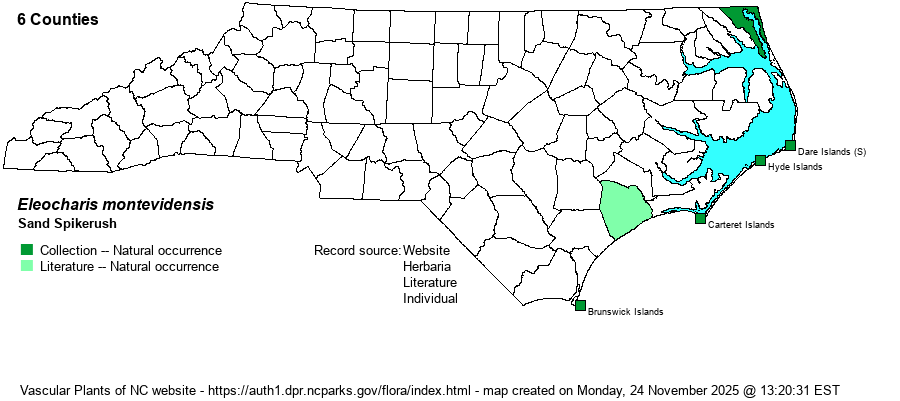| Author | Kunth | |
| Distribution | Tidewater region of the Outer Banks/barrier islands and the outer Coastal Plain.
NC, KS, and CA south into South America. | |
| Abundance | Rare. The NCNHP database lists 7 records, most still extant. However, individual populations may support many plants -- sites in Buxton Woods (Dare County) and Camp Lejeune (Onslow County) are ranked as excellent quality. The website editors suggest a State Rank of S1S2; this is a Significantly Rare species. | |
| Habitat | Margins of intermittently ponded dune depressions, interdune swales, upper margins of brackish marshes. | |
| Phenology | Flowering and fruiting June-September. | |
| Identification | The stems can grow to 1.5 feet tall, but in NC usually half that or even less. The stems are tufted and connected to others via slender rhizomes. The floral scales are orange, turning orange brown in fruit. Seeds are 3-sided. It differs from E. fallax by the scale color and the dark brown seeds (vs. yellow or yellow-brown). | |
| Taxonomic Comments | See Sorrie and LeBlond (Phytoneuron 2014-8: 1-7) for discussion of its distinction from E. fallax.
The genus Eleocharis, the spikerushes, are unusual members of the sedge family in that the culms (flowering stems) are round or oval (rarely triangular) in cross-section, rather than triangular in the great majority of our sedges. In addition, leaf blades are absent; just 1-2 basal sheaths are present at the base of the culm. There is a single, cylindrical or narrowly ovoid, spikelet of florets at the culm summit. Details of achene (seed) shape, color, ornamentation, bristle length, and beak (tubercle) shape and size, are critical ID factors. | |
| Other Common Name(s) | None | |
| State Rank | S1 [S1S2] | |
| Global Rank | G5 | |
| State Status | SR-P | |
| US Status | | |
| USACE-agcp | FACW link |
| USACE-emp | FACW link |

